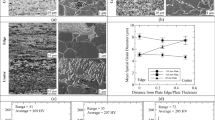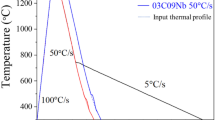Abstract
This research involved cold cracking in microalloyed steels, scrutinizing its corrosive impact on physical and mechanical attributes. A comprehensive analysis covers the base material, heat-affected zone, and weld material through microstructural examinations, hardness tests, fracture resistance tests, etc. The heat affected zone exhibits finer grain structures, elevating hardness. The weld region’s fracture toughness is compromised by finefeatures, inducing tear ridge, and micro-cracks, collectively diminishing overall toughness. Fractography identifies fracture causes and flaws. Non-destructive dye crack test detects surface very micro crack on the surface, while fracture analysis explores hydrogen’s influence. Findings reveal a substantial reduction in CTOD and J-fracture resistance in the weld zone decrease that is attributed to lower weld zone ductility. Weld regions exhibit 35 % lower ductility than the base material, with fractography revealing reduced energy absorption and diminished fracture toughness. The study guides improvements in oil and gas pipeline for safety and durability measures.
Similar content being viewed by others
Abbreviations
- J IC :
-
Internal crack growth resistance
- A 0 :
-
Initial crack length
- W :
-
Specimen width
- S :
-
Span of the sample
- δ t :
-
Defect assessment in welded structure
- δ e :
-
Elastic component of CTOD
- δ p :
-
Plastic component of CTOD
- I max :
-
Maximum stress intensity factor
- E :
-
Young’s modulus
- σys :
-
Yield strength
- v :
-
Poisson’s ratio
- P c :
-
Plastic component of crack mouth opening displacement
References
M. K. Nag and P. Kumar, Synthesis and characterization of high-performance blended alkali-activated geopolymer (FA/GBFS) from industrial wastes, Synthesis and Characterization of High-Performance Blended Alkali-Activated Geopolymer (FA/GBFS) from Industrial Wastes, 47 (2023) 2051–2071.
M. K. Nag and P. Kumar, Fabrication and characterization of woven and comingled nonwoven sheet polypropylene hybrid composite by recycling and alkali-treated jute waste fibers, Proceedings of the Institution of Mechanical Engineers, Part C: J. of Mechanical Engineering Science, 237 (2023) 3630–3649.
E. Abohamzeh, F. Salehi, M. Sheikholeslami, R. Abbassi and F. Khan, Review of hydrogen safety during storage, transmission, and applications processes, J. of Loss Prevention in the Process Industries, 72 (2021) 104569.
H. B. Navaid, B. Humza, E. Hossein and M. Watson, A comprehensive literature review on the challenges associated with underground hydrogen storage, International J. of Hydrogen Energy, 48(28) (2023) 10603–10635.
C. I. Ossai, B. Boswell and I. J. Davies, Pipeline failures in corrosive environments-A conceptual analysis of trends and effects, Engineering Failure Analysis, 53 (2015) 36–58.
M. K. Nag, P. Kumar and M. K. Paswan, Environmental impacts from the system of solar energy, Recent Advances in Power Systems: Select Proceedings of EPREC 2020, 699 (2021) 453–465.
M. K. Nag and P. Kumar, Fabrication and characterization of laminated natural fibers and SS303 wire mesh reinforced epoxy-based hybrid composite, Proceedings of the Institution of Mechanical Engineers, Part L: J. of Materials: Design and Applications, 238 (2024) 73–99.
M. K. Nag and P. Kumar, Optimization of cost and performance of the material used in the mechanism unit of Air Circuit Breaker (ACB) based on various analysis approach, Proceedings of the Institution of Mechanical Engineers, Part B: Journal of Engineering Manufacture, 238(4) (2024) 549–561.
P. Chowdhury and H. Sehitoglu, Mechanisms of fatigue crack growth-a critical digest of theoretical developments, Fatigue & Fracture of Engineering Materials & Structures, 39(6) (2016) 652–674.
N. Yurioka and H. Suzuki, Hydrogen assisted cracking in C-Mn and low alloy steel weldments, International Materials Reviews, 35 (1990) 217–249.
S. M. Hasan, F. Khan and S. Kenny, Probabilistic transgranular stress corrosion cracking analysis for oil and gas pipelines, J. of Pressure Vessel Technology, 134 (2012) 051701.
A. L. Mohammed, B. Oyeneyin, B. Atchison and J. Njuguna, Casing structural integrity and failure modes in a range of well types-a review, J. of Natural Gas Science and Engineering, 68 (2019) 102898.
M. K. Nag, A. Shrivastava and K. Solanki, Active cooling system incorporated in a portable laptop cooling pad, International J. of Thermal Energy and Applications, 8 (2022) 1–8.
M. Wasim, M. B. Djukic and T. D. Ngo, Influence of hydrogen-enhanced plasticity and decohesion mechanisms of hydrogen embrittlement on the fracture resistance of steel, Engineering Failure Analysis, 123 (2021) 105312.
E. Ohaeri, U. Eduok and J. Szpunar, Hydrogen related degradation in pipeline steel: a review, International J. of Hydrogen Energy, 43(31) (2018) 14584–14617.
J. L. Alamilla, E. Sosa, C. A. Sánchez-Magaña, R. Andrade-Valencia and A. Contreras, Failure analysis and mechanical performance of an oil pipeline, Materials & Design, 50 (2013) 766–773.
A. Cheng and N. Z. Chen, Fatigue crack growth modelling for pipeline carbon steels under gaseous hydrogen conditions, International J. of Fatigue, 96 (2017) 152–161.
J. A. Ávila, C. O. F. T. Ruchert, P. R. Mei, R. R. Morinho, M. T. P. Paes and A. J. Ramirez, Fracture toughness assessment at different temperatures and regions within a friction stirred API 5L X80 steel welded plates, Engineering Fracture Mechanics, 147 (2015) 176–186.
M. Elboujdaini and R. W. Revie, Metallurgical factors in stress corrosion cracking (SCC) and hydrogen-induced cracking (HIC), J. of Solid State Electrochemistry, 13(7) (2009) 1091–1099.
S. A. David, J. M. Vitek, R. W. Reed and T. L. Hebble, Effect of Rapid Solidification on Stainless Steel Weld Metal Microstructures and Its Implications on the Schaeffler Diagram, Oak Ridge National Lab, USA (1987) No. ORNL/TM-10487.
M. K. Nag, Lifetime estimation and surface degradation of MCCB contact tips due to multiple electrical interruptions, Proceedings of the Institution of Mechanical Engineers, Part C: J. of Mechanical Engineering Science, 238(5) (2024) 1466–1482.
J. E. Ramirez, S. Liu and D. L. Olson, Dual precipitation strengthening effect of copper and niobium in high strength steel weld metal, Materials Science and Engineering: A, 216(1–2) (1996) 91–103.
A. B. Forero, M. Núñez and I. S. Bott, Analysis of the corrosion scales formed on API 5L X70 and X80 steel pipe in the presence of CO2, Materials Research, 17 (2014) 461–471.
Acknowledgments
This research is made possible through the invaluable support of various laboratory facilities, with special recognition to TML vendors. A heartfelt appreciation goes to Mr. Amitabh Kumar Ankit, Senior Engineer at Atlantic, Gulf & Pacific (AG&P) Oil and Gas Company, for generously sharing his exceptional technical expertise, which greatly enriched this work.
Author information
Authors and Affiliations
Corresponding author
Additional information
Mukesh Kumar Nag is a research scholar in Mechanical Engineering at the National Institute of Technology, Jamshedpur, India. Before pursuing his doctoral program, he gained professional experience at TATA Motors Ltd., Jamshedpur, General Electric, and ABB, Hyderabad, India. He holds a diploma from the Indo Danish Tool Room, Jamshedpur, a Bachelor of Engineering from The Institution of Engineers (India), Kolkata, and a Master of Technology from the National Institute of Technology, Jamshedpur. His research focuses on aeroelastic composite structures, optimization of process and product parts costs, and enhancing performance in agri-food storage systems.
Rights and permissions
About this article
Cite this article
Nag, M.K. Experimental studies on micro alloyed steel used in oil and gas industries. J Mech Sci Technol 38, 2465–2473 (2024). https://doi.org/10.1007/s12206-024-0425-1
Received:
Revised:
Accepted:
Published:
Issue Date:
DOI: https://doi.org/10.1007/s12206-024-0425-1




